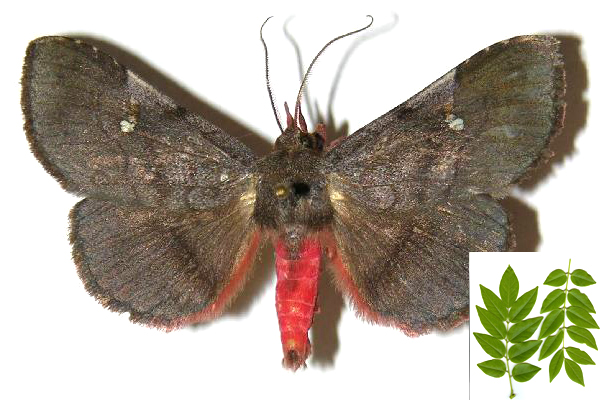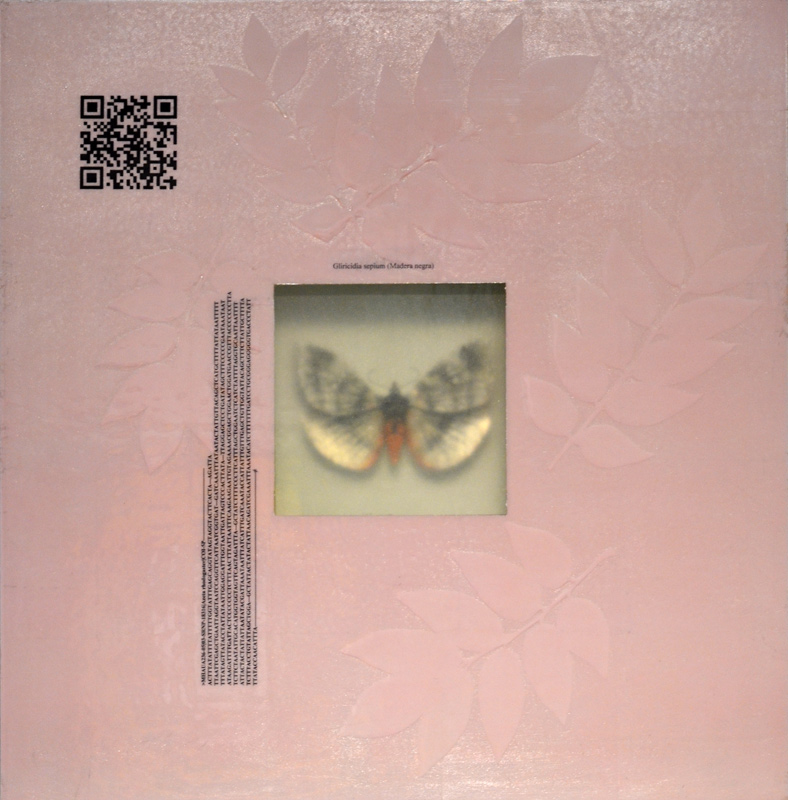Butterflies and Their Food Plants
Azeta rhodogaster Moth
Gliricidia sepium Host Plant
Costa Rica
From the researcher's perspective...
If you see a noctuid moth in ACG with a red abdomen, it is Azeta rhodogaster. There is no other like it. Equally, as the bright red abdomen suggests, this species is rather more diurnal and rather more inclined to fly when a predator approaches, than are many hundreds of other species of ACG Noctuidae. It perches exposed on the foliage, watches for movement with its large eyes, and flees when approached. It is very likely that the red abdomen functions as do the yellow hind wings on so many noctuids: the searching bird zeroes in on the red as the moth is in flight, but the red abruptly disappears when the moth alights. And the caterpillar of A. rhodogaster also steers the researcher away from aposematism. The pale greenish-yellowish-with-black dots caterpillars are host-specific to Gliricidia sepium (shown), a small to very large native tree of ACG dry forest. This dry forest tree has been introduced around the global tropics, in both dry and rain forest, as a living fence post. When this tree was planted as the support for barbed wire fences in the rain forest side of Costa Rica, A. rhodogaster was just one of the many dry forest species that moved from dry to rain forest pastures, following its food plant. A. rhodogaster caterpillars can reach quite spectacular abundances, defoliating their food plants if they are just saplings or young treelets. At these times, it is easy to collect many of the caterpillars so as to see what parasitoids are using them and it is apparently also easy for their parasitoids to find them. In one sample of 446 mostly last instar caterpillars collected during a population explosion from a few G. sepium treelets in ACG dry forest, Eucelatoria armigera, a medium-sized somewhat generalist tachinid fly, killed at least forty percent of the caterpillars. Interestingly, this species of caterpillar does not seem to have any species of parasitoid that is a specialist on it.
Dr. Daniel Janzen
DNA Barcode of Azeta rhodogaster
Accessed from Barcode of Life Data Systems
MHAUA236-05 | 03-SRNP-18316 | Azeta rhodogaster | COI-5P
TACTTTATATTTTATTTTTGGTATTTGAGCAGGTATAGTAGGTACTTCACTAAGATTATTAATTCGAGCTGAATT AGGTAATCCAGGTTCATTAATCGGTGATGATCAAATTTATAATACTATTGTTACAGCTCATGCTTTTATTATAAT TTTTTTTATAGTTATACCTATTATAATTGGAGGATTTGGTAATTGATTAGTCCCACTTATATTAGGAGCTCCTGA TATAGCTTTCCCCCGAATAAATAATATAAGATTTTGATTACTCCCCCCCTCTTTAACTTTATTAATTTCAAGAAG AATTGTAGAAAACGGAGCTGGAACTGGATGAACCGTTTACCCCCCCTTATCTTCTAATATTGCACATGGTGGTAG TTCAGTAGATTTAGCTATCTTTTCCCTTCATTTAGCTGGAATCTCATCTATTTTAGGTGCAATTAATTTTATTAC TACTATTATTAATATACGATTAAATAATTTATCATTTGATCAAATACCATTATTTGTTTGAGCTGTTGGTATTAC AGCTTTCTTATTGCTTTTATCTTTACCTGTATTAGCTGGAGCTATTACTATACTATTAACAGATCGAAATTTAAA TACATCTTTTTTTGATCCTGCGGGAGGGGGTGACCCTATTTTATACCAACATTTATTT


